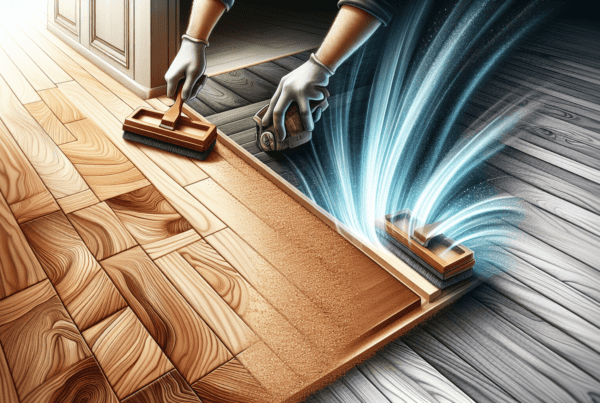Embarking on a journey to rejuvenate your home’s aesthetic can be quite the adventure, and if you’re focused on breathing new life into your floors, Ultimate Timber Floor Sanding & Finishing in Wellington offers the perfect solution. With years of experience and a dedicated team of professionals, we specialize in transforming worn-out wooden floors into mesmerizing masterpieces. Our refined techniques and attention to detail ensure that every project we undertake not only meets but exceeds expectations, promising a stunning and durable finish that will elevate the charm of your Wellington home.
Understanding Timber Floor Sanding
The Basics of Timber Floor Sanding
When we talk about renovating or refreshing our space, timber floor sanding plays a crucial role. It’s the process of removing the top surfaces of a wooden floor by sanding with abrasive materials. Essentially, it’s like giving our floor a facelift, removing all the wear and tear it has gathered over the years and bringing back the wood’s natural beauty and texture.
Benefits of Floor Sanding
Floor sanding isn’t just about aesthetics; it significantly improves the quality of our living space. It removes imperfections, stains, and old finishes, making the floor easier to clean and maintain. Additionally, it increases the durability of our floors, protecting them from future damage, and can even enhance the value of our property by giving it a more polished and refined look.
Tools and Equipment Used in Sanding
To achieve the perfect finish, we use a variety of tools and equipment in floor sanding. These include belt sanders, edge sanders, and orbital sanders, each serving a unique purpose in the sanding process. We also ensure we have dust extraction systems in place to keep our workspace clean and to reduce the health risks associated with airborne dust particles.
The Importance of Professional Sanding Techniques
Employing professional sanding techniques is paramount to achieving the best results. Proper technique ensures an even surface without dips or gouges. We pride ourselves on knowing the intricacies of the timber, understanding how to move the sanders, and determining the right amount of pressure to apply. This expertise guarantees that the final product is not only visually appealing but also structurally sound.
Preparing for Sanding
Clearing the Work Area
Before beginning the sanding process, it’s essential that we clear the work area. This means removing furniture, curtains, and any other items that might obstruct our work or be damaged by dust. A clean workspace allows us to move freely and ensures that the sanding is uniform across the floor.
Checking for Nails and Staples
One of the crucial preparatory steps we always take is to check the floor for protruding nails, staples, or any other metal fixtures. These can damage our sanding tools and create unsightly marks on the floor if not properly addressed.
Sanding Safety Measures
Safety is our top priority during the sanding process. We always wear protective gear, including masks, goggles, and ear protection, to shield ourselves from dust, noise, and any other potential hazards. Ensuring the space is well-ventilated is also a key aspect of maintaining a safe working environment.
Determining the Sanding Pattern
Deciding on the sanding pattern before we start is crucial to achieving an evenly sanded floor. We typically follow the wood grain direction for the majority of the sanding, using different techniques for problematic areas to ensure a consistent finish throughout.
The Sanding Process
Coarse Sanding for Rough Areas
The initial phase of sanding involves using coarse grit sandpaper to tackle the rough and damaged areas of the floor. This step is essential for leveling the floor and removing the old finish, setting the stage for the finer sanding to come.
Medium Sanding for Smoothing
After the floor has been leveled, we switch to medium grit sandpaper to smooth out the surface. This intermediate step removes any scratch marks left by the coarse sanding and prepares the wood for the final finish.
Fine Sanding for Finishing Touches
The final phase of sanding uses fine grit sandpaper to give the floor a smooth, polished look. This step is all about attention to detail and ensuring the surface is perfectly prepared for the finishing process.
Edge Sanding Techniques
Edges and corners require a special approach, as standard sanders can’t reach these areas effectively. We use edge sanders and sometimes manual sanding techniques to ensure these difficult areas receive the same level of care and finish as the rest of the floor.
Choosing the Right Sandpaper
Types of Sandpaper
There are various types of sandpaper available, each designed for specific stages of the sanding process. Aluminum oxide, silicon carbide, and ceramic are among the most commonly used abrasives in floor sanding. Each type has its unique properties and applications.
Grit Selection Guide
Choosing the right grit is crucial for achieving the desired finish. Lower grit numbers are coarser and used for initial sanding, while higher numbers are finer, used for the final finish. We carefully select the appropriate grit for each stage of the sanding process to ensure the best outcome.
Change Intervals and Techniques
Changing sandpaper at the right intervals is vital to maintain efficiency and achieve a smooth finish. We monitor the wear and tear of the sandpaper closely, changing it before it becomes too dull to prevent damage to the floor and ensure an even finish.
Impact of Sandpaper Choice on Floor Quality
The choice of sandpaper significantly impacts the quality of the finish. Using the wrong type or grit can result in scratches or an uneven surface. We meticulously select our sandpaper to enhance the natural beauty of the timber floor, ensuring a high-quality finish.
Finishing Options for Timber Floors
Types of Floor Finishes
Once the sanding is complete, we have a variety of finishing options to choose from. These range from polyurethane and varnishes to oils and waxes. Each type of finish offers different aesthetic and protective qualities, depending on the desired look and level of maintenance required.
Selecting the Best Finish for Your Floor
Choosing the right finish for our floor is a decision we don’t take lightly. We consider factors such as the usage of the room, the natural color of the wood, and the desired sheen level. We often discuss these aspects with our clients to ensure the chosen finish meets their expectations and lifestyle needs.
Application Techniques for Even Finishes
Applying the finish evenly is crucial for achieving a professional look. We use brushes, rollers, or sprayers, depending on the type of finish and the specific characteristics of the floor. Our skilled application ensures a smooth, streak-free surface that enhances the wood’s natural beauty.
Drying and Curing Times
Each finish has its drying and curing times, which we strictly adhere to. This patience ensures that the finish hardens adequately, providing a durable and long-lasting protective layer to the floor. Skipping or rushing this step could compromise the quality and longevity of the finish.
Maintenance After Sanding and Finishing
Daily Floor Care Tips
After investing in sanding and finishing our timber floors, maintaining them properly is key to preserving their beauty. We advise on daily care tips, such as using soft brooms for dusting and microfiber mops for cleaning, which help avoid scratches and damage.
Preventive Measures to Protect Timber Floors
We also recommend preventive measures such as using furniture pads, placing mats at entrances, and maintaining a stable indoor humidity level to protect the floors from premature wear and tear.
Dealing With Stains and Spills
Accidents happen, but quick action can prevent permanent damage. We provide guidance on dealing with stains and spills, recommending specific cleaning products and techniques depending on the type of finish and the nature of the stain.
When to Refinish Your Floor Again
Even with the best care, timber floors will eventually show signs of wear. We help our clients understand when it’s time to consider refinishing their floor, ensuring it remains a beautiful and valuable part of their home for years to come.
Troubleshooting Common Sanding and Finishing Issues
Dealing With Sanding Marks and Scratches
Sanding marks and scratches can detract from the beauty of the floor. We have strategies for minimizing these issues during the sanding process and can also address them should they arise after the fact, ensuring a seamless and attractive finish.
Fixing Uneven Finishes
Uneven finishes can result from a variety of factors, including improper application or uneven drying conditions. We employ techniques to correct these issues, often involving light sanding and recoating to achieve a uniform appearance.
Addressing Peeling and Flaking Finishes
Peeling and flaking finishes are signs of adhesion issues, possibly due to contamination or moisture. We assess the underlying cause and take corrective action, which might involve stripping the finish and starting the process over to ensure a durable and attractive result.
Solutions for Sticking Dust Particles
Dust particles can stick to the finish if not properly cleaned before application. We stress the importance of a dust-free environment during the finishing process and offer solutions to remedy this issue if it occurs, ensuring a smooth, clean finish.
Professional Versus DIY Sanding and Finishing
Pros and Cons of DIY Sanding
DIY sanding and finishing can be tempting, offering savings on costs and the satisfaction of personal accomplishment. However, without the right tools, skills, and understanding of the materials, it’s easy to make costly mistakes that can damage the floor and require professional remediation.
When to Hire a Professional
We believe in the value of professional sanding and finishing, especially for those seeking a flawless finish and wanting to preserve the integrity of their flooring. Hiring a professional can save time, reduce the risk of errors, and ensure the use of the right materials and techniques for the specific type of timber flooring.
Cost Comparison
While DIY might seem less expensive upfront, the costs can quickly escalate if mistakes occur. Professional services, on the other hand, offer the assurance of quality and longevity, possibly saving money in the long run by avoiding the need for repairs or rework.
Ensuring Quality in Professional Services
When choosing a professional service, we advise looking for a team with experience, good reviews, and a clear process from start to finish. Transparency about costs, timeframes, and materials used is also crucial to ensure quality and satisfaction with the final outcome.
Eco-Friendly Sanding and Finishing Options
Sustainable Timber Flooring Choices
We’re mindful of our environmental impact and suggest sustainable timber flooring choices, including reclaimed or certified sustainably sourced wood, to our clients who share our commitment to eco-friendly practices.
Low-VOC Finishes
Low-VOC (Volatile Organic Compound) finishes are better for both the environment and indoor air quality. We promote the use of these finishes, as they provide the beauty and protection we seek for our floors without the harsh chemicals.
Recycling Sanding Dust
Sanding generates a significant amount of dust, which we carefully collect and dispose of in an environmentally friendly manner. Where possible, we explore options for recycling this by-product, reducing waste and supporting sustainability.
Eco-Friendly Maintenance Tips
Maintaining timber floors in an eco-friendly manner is easier than many think. We share tips on using natural cleaning products and methods that minimize harm to the environment and are safe for families and pets.
The Future of Timber Floor Sanding and Finishing
Advancements in Sanding Technology
We’re excited about the future of timber floor sanding and finishing, with advancements in sanding technology making the process faster, cleaner, and more efficient. Newer machines with better dust extraction systems and more effective sanding capabilities promise improved results with less environmental impact.
Innovations in Eco-Friendly Finishes
The trend towards eco-friendly finishes is growing, with innovations leading to more durable, beautiful, and less toxic options. We anticipate continued improvements in this area, offering our clients finishes that meet their aesthetic desires without compromising on eco-friendliness.
Trends in Timber Flooring Designs
Timber flooring designs are continually evolving, with new trends in colors, textures, and patterns emerging. We stay abreast of these trends, ensuring we can offer our clients contemporary flooring options that reflect the latest in design and style.
Predictions for Timber Floor Care
The future of timber floor care looks promising, with a focus on products and practices that are both effective and environmentally responsible. As professionals in the industry, we’re committed to adopting and promoting these advances, ensuring our floors remain beautiful, durable, and kind to the planet.







